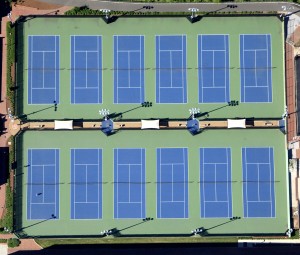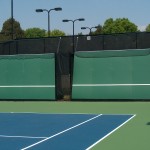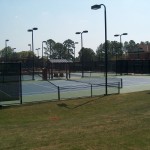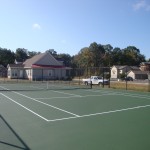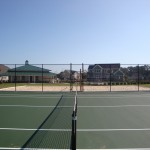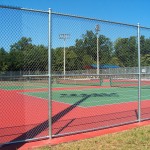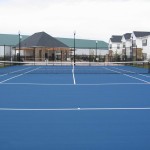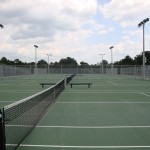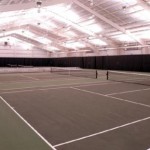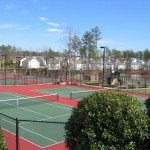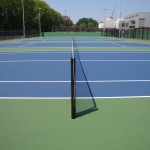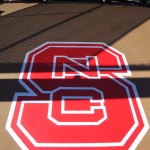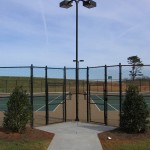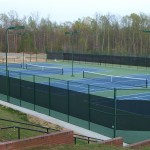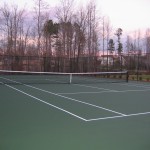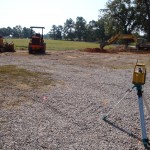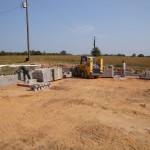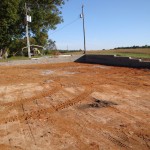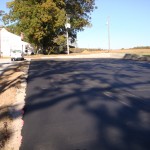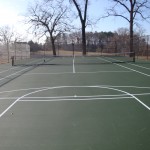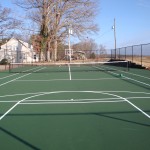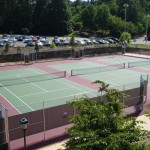
Salisbury Office (800) 458–3024
New Construction
PLANNING YOUR TENNIS COURT
If you are considering a new tennis court(s), here are some basic requirements to think about:
TENNIS COURT SIZE AND SPACE REQUIREMENTS
A standard tennis court for doubles play is 60’ x 120’, measured from fence to fence. For additional courts in a battery, add a minimum of 48’ to the width. For example, two courts would measure 108’ x 120’, three courts would be 156’ x 120’, etc. The graded area for the court should extend a minimum of 3’ beyond each side of the court, i.e. 66’ x 126’. This will depend on the topography of the site, drainage requirements, and landscaping needs. If trees must be cleared, the cleared area should extend a minimum of 15’ beyond each side of the court, depending on the size and type of trees to be cleared. This precaution is to minimize potential damage from encroaching tree roots, leaf debris and staining of the surface.
TENNIS COURT ORIENTATION
The court should be oriented as close to north/south as possible (the net line should be on an east/west axis), to minimize the effects of sun on play, particularly in the early morning and late afternoon.
PERIMETER COURT DRAINAGE AND LANDSCAPING
Good drainage around the court is critical to its longevity. Building on steeper terrain will require different drainage, and possibly retaining wall(s), compared to a court built on flatter, open ground. Landscaping around the edge of the court should be limited to prevent encroachment into the court and possible damage in the future. Landscaping in general should consider maintaining good access for equipment, etc. in the future.
FENCING YOUR TENNIS COURT
The standard height for ball control fencing is 10 ft., although 8’ or 12’ heights may be used in certain situations. The fence on the sides may be reduced to a 3’ or 4’ height, or eliminated all together. Corners of the court may be 90 degrees, or cut off diagonally. Types of fencing include galvanized chain link, vinyl-coated chain link, and netting on either a wood or steel frame.
TENNIS COURT WINDSCREEN
You may contemplate installing windscreen on your court for the following reasons:
- Reduce the effects of wind on play
- Privacy
- Provide a contrasting, uniform background to improve sight of the ball during play
High winds can be quite damaging to a fence covered with windscreen, as even an open-mesh windscreen can create a lot of wind resistance. You should consider your location, and its tendency towards exposure to high winds. We do not recommend installing anything more than a 6’ high windscreen (which is centered on the fence) on a fence unless it has been specifically reinforced for windscreen loads (i.e. shorter spacing between fence posts, stronger fence posts, back bracing of fence posts). Depending on your needs, you do not necessarily have to cover the entire fence with windscreen i.e. you may cover the ends of the courts only, and leave the sides open, or you may have a particular view that you want to hide.
TENNIS COURT LIGHTING
Lighting your tennis court can increase the enjoyment and available use of your court by extending the hours it can be played on, and in warmer weather, it can provide play at cooler times of the day. Your main decision points involve how much light you need, typically measured in foot candles, (the older the player, the more ambient lighting is required to effectively see the ball), and how uniform the light levels are at various points on the court. (Uniformity, or variation in light levels is critical to the overall effectiveness and enjoyment of the lighting system). With the concerns about light pollution and the resulting ordinances and building codes that have been put in place, we typically recommend a lower mast, direct light “shoebox” type fixture that uses a Metal Halide lamp. This type of system provides a more concentrated light coverage than a floodlight approach, can be maintained more easily, and is cost effective (long lamp life and efficient cost of operation). When contemplating lights, proximity of the court(s) to your property lines, extent of vegetative buffers available, and ease of access for large installation/maintenance equipment should also be considered. We can help you with these issues.
OTHER TENNIS COURT ACCESSORIES
There are a number of other accessories that you might consider in order to maximize your enjoyment:
- Benches
- Shade structures
- Waste receptacles and ball caddies
- Scorekeepers
- Surface maintenance tools (i.e. roller squeegees, brooms, drag brushes, rollers, etc.)
- Ball machines
- Practice backboards (i.e. hitting walls)
- Water coolers
Court One offers a full line of tennis court accessories and can answer any questions that you might have. We want you to have maximum enjoyment from your big investment!
